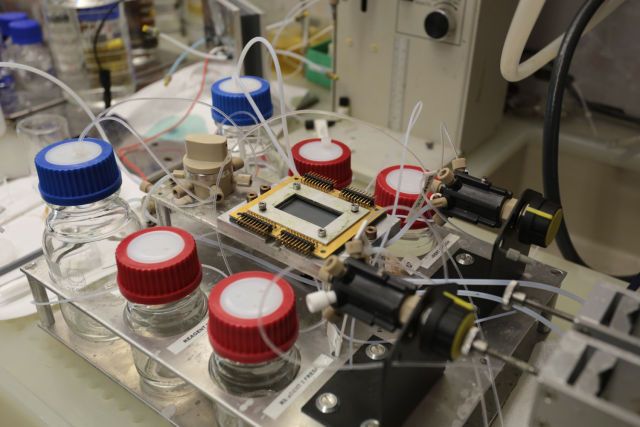Category: biotech/medical

Undoing Sugar Damage: First Synthesis Of Culprit Glucosepane
Sugars may taste divine, but they’re also highly reactive molecules that progressively stiffen your body in a process called glycation. Scientists have now synthesised the primary molecule formed in glycation for the first time, leading to hope that drugs can be designed to break them apart.
What is glycation?
In our bodies sugars continuously react with proteins in an unregulated manner in a process known as glycation. This leads to the formation of abnormal chemical modifications of the protein which may impair its normal function. These sugar-modifications are collectively known as advanced glycation end products (AGEs) and can be subdivided in two main categories. First are the modifications that affect a single amino acid. The second category consists of modifications that link two amino acids together in a structure called a crosslink.


Scientists have found a way to 3D-print embryonic stem cell ‘building blocks’
Pluripotent cells are great, but they can be difficult to steer into growing the way you want. Now scientists have found a new way to create 3D-printed ‘building blocks’ of embryonic stem cells (ESCs), which could be used for growing micro-organs, performing tissue regeneration experiments, testing medication and other biology research purposes.
While bioprinting with ESCs is not entirely new, until recently researchers have only managed to produce two-dimensional sheets of cells. Now a team of scientists from Tsingua University in China and Drexel University in Philadelphia have published a study in Biofabrication, introducing a novel technique for printing a grid-like 3D structure laden with stem cells.
In normal biological conditions ESCs naturally tend to cluster together into spherical ‘embryoid bodies’ – clumps of pluripotent cells which can go on to develop into any type of cell or tissue in the human body.

A Bright Future: Breakthrough Gene Editing Trial Reverses Leukaemia
A pioneering gene editing therapy has shown remarkable success in a unique trial at Great Ormond Street, paving the way for a wave of gene editing trials.
A world first
Not long ago, 1 year old Layla Richards had an incurable form of leukaemia and the prognosis wasn’t looking good. After a determined search for a cure, Layla underwent an experimental therapy in which ‘designer’ immune cells were implanted that would destroy and replace her own ailing immune system.

Inside the 50-year-quest to build a mechanical heart
Steve Williams couldn’t breathe. The former athlete had cardiomyopathy, which occasionally choked his lungs with fluid, making him gasp for air. But this felt different; Williams felt like he was dying. He was raced to an Orange County hospital, and shortly after checking in, his heart stopped. For 30 minutes, ER workers compressed his chest in an attempt to revive him. At one point, his wife Mary remembers being called into his room to say goodbye to her husband of 24 years. It seemed Williams was a dead man.
Incredibly, doctors rebooted Williams’ heart — but for three days, he was in an induced coma, his body packed in ice to minimize brain damage. When he woke up, his mental facilities were intact, but his body was ravaged. His liver was congested, fluid reappeared in his lungs, and his heart’s right and left ventricles were practically destroyed, making it hard for blood to circulate throughout his body. Without a heart transplant, he would soon die.

Genes Responsible for Limb Regeneration in Crickets Identified
Researchers just identified part of the epigenetic pathways responsible for limb regeneration in the two-spotted cricket Gryllus bimaculatus.
Cut off the leg of an insect, and not only will the insect survive, but the leg will also grow back after some time. Cut off the leg of a human, and they’ll bleed out without proper medical attention (alas for us). Ultimately, insects are able to accomplish this amazing feat because they retain the biological pathways required for cells to differentiate and reorganize at a wound site, which is required in order to regenerate entire limbs.
The processes involve the dedifferentiation and redifferentiation of cells; however, the exact nature of the process is largely a mystery. Fortunately, some light has recently been shed on the matter, as researchers at Okayama University identified key genes involved in the regenerative process of the two-spotted cricket, Gryllus bimaculatus.

New discovery changes everything we know about how blood is made
Stem-cell scientists have upended current thinking on the way human blood is produced inside the body, opening the way for new studies and new treatments. The findings of principal investigator John Dick and his team from the University of Toronto in Canada challenge ideas that have been in place since the 1960s.
Essentially, the new research suggests that blood is formed in fewer steps than previously believed: earlier evidence indicated stem cells went through several intermediate steps before becoming white or red adult cells, like branches coming out from a tree trunk. Dick and his team think the process is much quicker and simpler, though their findings have yet to be confirmed by independent researchers.
“The whole classic ‘textbook’ view we thought we knew doesn’t actually even exist,” said Dick. “Instead, through a series of experiments we have been able to finally resolve how different kinds of blood cells form quickly from the stem cell – the most potent blood cell in the system – and not further downstream as has been traditionally thought.”

Stem-cell scientists redefine how blood is made
Stem-cell scientists led by Dr. John Dick have discovered a completely new view of how human blood is made, upending conventional dogma from the1960s.

3D Printed Guide for Nerve Regeneration successfully tested on Animals, Clinical testing on humans to begins soon
According to the Mayo Clinic, the Nerve regeneration is a complex process, because of its complexity, regrowth of nerves after injury or disease is extremely rare. Nerve damages more often than not are incurable and cause permanent disability, but now the scientist has proved that Advanced 3D printing methods could hold a possible cure for such patients.
To prove the proof of concept, a physically disabled rat was chosen as a test subject. The scientist used a specially designed 3D scanners and 3D Printers to create a custom silicone guide, 3D-printed chemical cues were added to the guide to promote both motor and sensory nerve regeneration. This was then implanted into the rat with surgically grafting it to the cut ends of the nerve. The operation was a extremely successful and the rat showed tremendous improvement in the way it walked within 10 to 12 weeks.
The Lead researcher of this medical breakthrough, Michael McAlpine, a mechanical engineering professor from the University of Minnesota said “This represents an important proof of concept of the 3D printing of custom nerve guides for the regeneration of complex nerve injuries,”